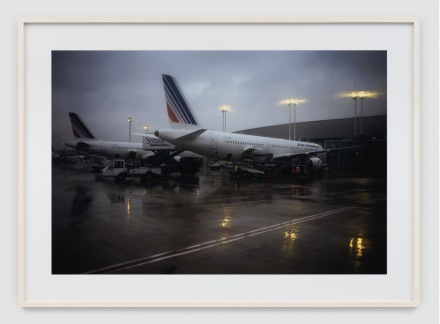
Fischli Weiss, Untitled (Paris/Air France) (1998), via Eva Presenhuber
On view this month at Galerie Eva Presenhuber presents Airports and Cars, the gallery’s fourth exhibition by Peter Fischli and the late David Weiss. Fischli Weiss began the Airports series in 1987 and continued it for 25 years, a project that saw them repeatedly photograph and document the various scenes and landscapes of international airports, focusing on tarmacs and loading zones—the abstract-opaque logistical space, which passengers predominantly glimpse through panes of glass and see themselves detached from.
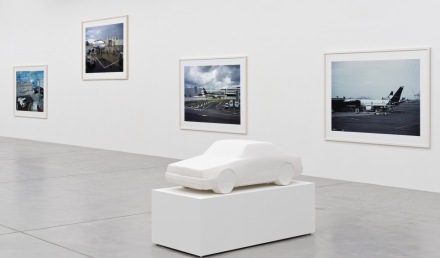
Fischli Weiss, Airports and Cars (Installation View), via Eva Presenhuber
The works were formative in the continued evolution of the artists’ exploration of modernity, of the architectures and imagery of the modern world, and their interconnectivity with subtle emotional undertones. The first photographs were taken at a time when the notion of photography as art was gaining traction—partly due to the Düsseldorf School of Photography, members of which Fischli Weiss were in dialog. Artistic positions were established that presented documentary photographs as tableaus in exhibition spaces. Similarly, the Airports have a structural affinity to easel pictures in size and presentation. In its pictorial rhetoric and form of distribution, the Airports series can be linked to photographic projects of early conceptual art—such as Twentysix Gasoline Stations (1963) by Ed Ruscha or Homes for America (1966–1967) by Dan Graham.
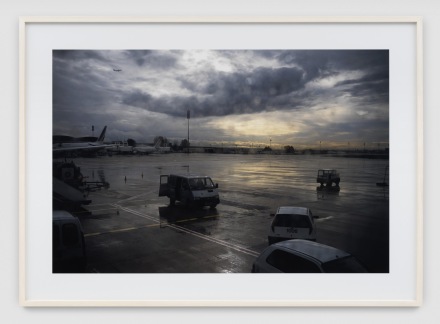
Fischli Weiss, Untitled (Paris) (1987), via Eva Presenhuber
The Airports series seems to be the counterpart of the series of works titled Visible World and—as a historical source—tells of the changing social significance of flying. The project did span a generation. The ecology and mobility debates—but also the aviation industry itself—have changed considerably since the beginnings of the series of works. There are few aircrafts from discount airlines in the series, but some from airlines that went bankrupt in the 1990s. The first works were created at the end of the golden age of airlines in the post-war order when aviation was associated with worldly sophistication, national pride, and civilizational utopias rather than terrorism and global warming.
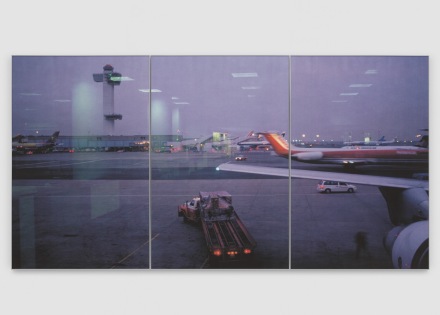
Fischli Weiss, Untitled (Airport) (2008), via Eva Presenhuber
Cars underwent a similar symbolic metamorphosis and can be seen in many of the photographs in the exhibition, providing the viewer with geographic and historical context. The Cars plaster sculptures do not reproduce specific models and are presented as isolated, prototypical fragments of the everyday order. This phenomena is presented without judgment; rather, there seems to be an emphatic turning towards these symbols of the “wrong life.” A small radio on a console plays content from a local station in a loop, conveying the impression of a specific, local reality—outside, beyond the gallery.
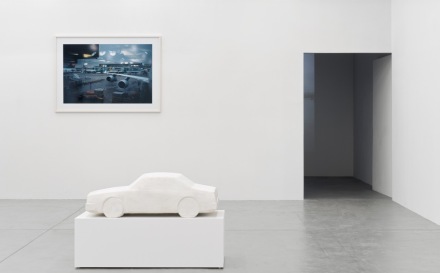
Fischli Weiss, Airports and Cars (Installation View), via Eva Presenhuber
The works show architectural spaces that the anthropologist Marc Augé described as non-places in 1992. Airports, asylum centers, highways, and malls are considered by Augé to be the paradigmatic places of globalized late capitalism. They are transitory functional places and not historically evolved spaces. Non-places are determined by economic transactions and contractual relationships. They are highly regulated special legal zones. They form an anonymous, generic space in which the social identity of individuals and the experience of time dissolve. The artists have examined the airport in its moral-aesthetic ambivalence and also documented their own reality as internationally exhibiting artists. The art market—as well as the institutional art world—is closely linked to transit spaces and stands outside territorial ties. Galleries and museums can be described as part of the economy of non-places.
Exploring these notions of space, and as a result, portions of reality, as constructed, the show here underscores the subtle yet commanding philosophy of the pair.
– C. Rhinehart
Read more:
Galerie Eva Presenhuber [Exhibition Site]



